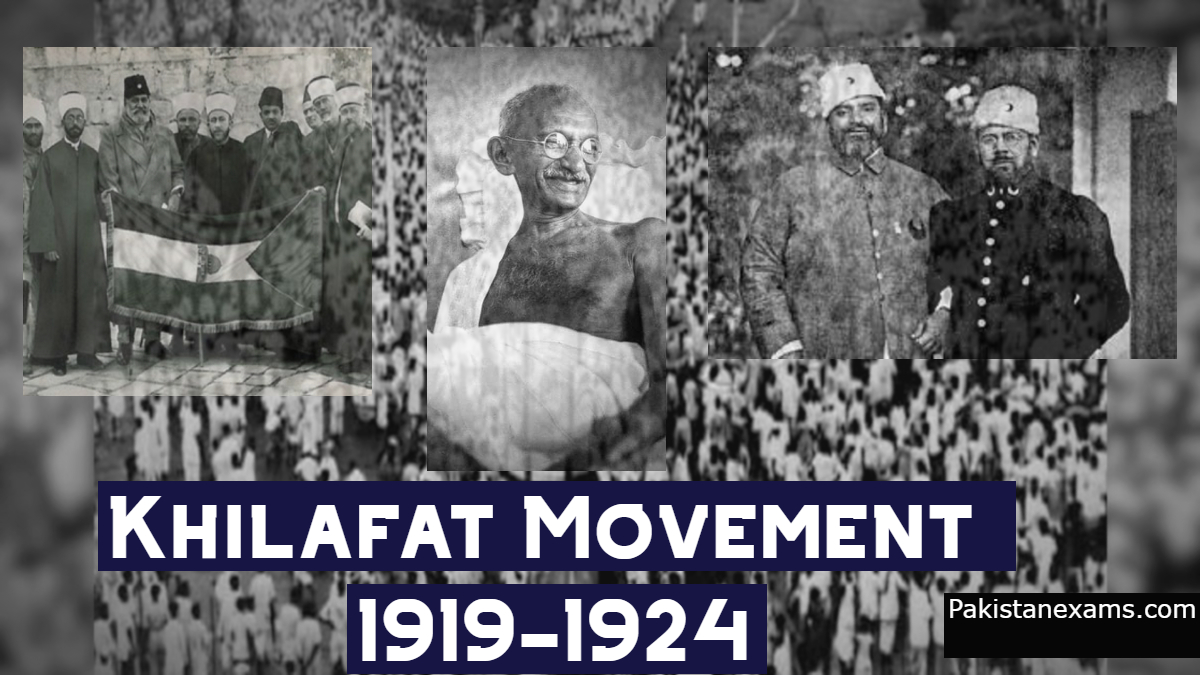After the World War I, the Ottoman Empire faced disintegration, so the Muslims of India launched the Khilafat Movement. Their prominent leaders were Maulana Muhammad Ali and Maulana Shaukat Ali. The general impression among the Muslims of India was that the Western powers were engaged in a war against Islam throughout the world.
Moreover, the Ottoman Empire was the main Muslim power that had kept a similarity to the power and authority of the Khilafat. Therefore, the Muslims of India needed to save the Islamic political power from elimination.
Objectives of the Khilafat Movement
- To keep the Institution of Khilafat.
- Safeguard the sacredness of the Holy Places.
- To protect the geographical and territorial integrity and sovereignty of the Ottoman Empire.
Salient Features of the Khilafat Movement
Khilafat Committee by Ali Brothers
On March 20, 1919, the Khilafat Committee was established in Bombay. Its first president was Seth Jan Mohammad Chottani. Khilafat Committee organized various public meetings to gain support from the public.
Khilafat Delegation by Maulana Mohammad Ali Jauhar
The Khilafat Delegation was a significant event of the Movement. In December 1919, the Khilafat Committee prepared a delegation, which was sent to England under the leadership of Maulana Mohammad Ali Johar. Its purpose was to see the British Prime Minister, Cabinet Members, and Members of Parliament.
Therefore, the delegation visited England in 1920. The leaders of the delegation addressed the House of Commons and saw the British Prime Minister, Lloyd George who paid no attention to the delegation’s demand. The delegation stayed in London for eight months and won many hearts and sympathies of people. However, it returned to India unsuccessful in October 1920.
Non-Cooperation Movement by Gandhi
The delegation to England was not successful because the British did not take the demands of the Khilafat Delegation seriously. Therefore, they decided to launch a movement of Non-Cooperation. Congress also started supporting the Khilafat Movement.
As a result, the leaders of the two met at Amritsar and decided to launch a country-wide agitation under the leadership of Mahatma Gandhi. The agitation was against the British government. The Jamiat-ul-Ulama Hind issued a Fatwa of Tark-e-Mawalat. The following points were included in it:
- Abandonment of all Government titles.
- Boycott of legislature and court.
- Withdrawal of students from educational institutions.
- Resignation from government posts.
- General civil disobedience.
Hijrat Movement of 1920
Maulana Abul Kalam Azad and Maulana Abdul Bari Farangi issued the Fatwa of Hijrat. Some 18,000 Indian Muslims migrated to Afghanistan. Initially, Afghanistan welcomed the refugees, but soon it closed down its borders because of its limited resources. The Muslims returned to India in a miserable condition.
Chauri Chaura Incident of 1922
The Chauri Chaura incident took place on February 4, 1922, at Chauri Chaura in the Gorakhpur district of the United Province (modern Uttar Pradesh). The members of the Non-cooperation Movement and the police clashed with each other. In the clash, the protestors set a police station on fire. Resultantly, three civilians and 22 policemen lost their lives. The British Government sentenced 19 members of the mob to death sentences and 110 to life imprisonment.
End of the Khilafat Movement
During the Khilafat Movement, the British government imprisoned thousands of Indians, which weakened the movement. Secondly, the main reason that caused a death blow to the Khilafat Movement was the announcement of Gandhi to discontinue the Non-Cooperation Movement after the incident of Chaura Chauri. Moreover, in 1924, Kamal Ataturk set up a government on a democratic basis in Turkey by abolishing Khilafat as a system of government. It served as a finishing blow to the Khilafat Movement of India.
Why did the Khilafat Movement fail?
Mismatch of Turkish and Indian Preference
Indian Muslims wanted Khilafat but Turks wanted democracy. Kamal Ataturk abolished the Institution of Khilafat and established a democratic government in Turkey. It was another cause of the failure of the Khilafat Movement.
Lack of unity amongst Hindus and Muslims
The difference between the Hindus and Muslims became even more noticeable during the Khilafat Movement. When the Movement reached at peak, Mahatma Gandhi gave up on the movement and quit the Non-Cooperation movement.
Importance of the Khilafat Movement
Two Nation Theory
The Khilafat movement was a live demonstration of the Two Nation Theory, given by Sir Syed Ahmad Khan. When the Khilafat Movement was at its peak, Gandhi announced to quit the Non-Cooperation movement. This act of Mr. Gandhi caused the failure of the movement. Hence, it proved that Muslims can never trust the Hindu leadership.
Political Consciousness among Indian Muslims
Although the Khilafat Movement failed, it spread political awareness among Indian Muslims. The reason is that they were active in political gatherings and campaigns during the Khilafat Movement. It helped them understand political movements.

